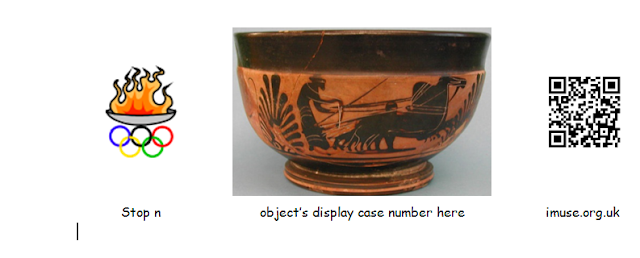This note gives the numbers taking part in the imuse-organised activities in the Museum of English Rural Life, Reading, UK, half-term week February 2012 .
Number of children: 134
Quite a few more than: 85 adults
Total number of people more than: 219
The Great Cheese Mystery Trail is described in other posts.
Daily breakdown:
Tuesday: 30 children; 21 groups = min no adults. Total at least: 51
Wednesday: 20 children; 13 groups = min no adults. Total at least: 33
Thursday: 32 children; 18 groups = min no adults. Total at least: 50
Friday: 39 children; 26 groups = min no adults. Total at least: 65
Saturday: 11 children; 5 groups = min no adults. Total at least: 16
Sunday:2 children; 2 groups = min no adults. Total at least: 4
The Great Reading Cheese Mystery 'full story' can be read online (available
through
www.imuse.org.uk which children had on the bottom of their
certificates at the end (though quite often we forgot to point this out).) The online story has been opened 35 times to date.
The 'vagueness' of some clues (referred to in Rob's post, below) led to increased interaction between visitors and the imuse people manning the 'Forensic Lab'. This is a plus for a communications-charity project! It would be a minus if we wanted to have trails where the visitors could do them unaided and/or we didn't have a fairly highly manned central place visitors could go for help/discussion.
Feedback from children was almost universally enthusiastic. They were given a chance to 'vote' at the end on whether it was 'fun', 'sort of OK', 'not fun' by putting the appropriate smiley face card into the i-nigma machine (the iPad). We weren't very careful about asking everyone to vote, and sometimes a vote was put in for a group rather than individually.
The more adult vote ('we found out quite a bit', 'we found out a little', 'we didn't find out anything new') had even lower numbers of participants as we rather got involved in the business of cheese sniffing, hearing what people had to say and managing the certificates and the machine.
For what it's worth the feedback into the machine was:
It was fun: 79; it was sort of OK: 8; it wasn't fun: 2;
We found out quite a bit: 20; we found out a little:8; we didn't find out anything new: 2
Probably the place where adults found out most was at the end where there could be a discussion about Berkshire not being a traditional cheese county, but that local cheese making had a renaissance (two were named in the trail and contained local place names), that the BDI dairy was next door and now the cafe and that Reading still had a strong interest in dairying and cheese-making courses in particular. Several adults said they'd never known that and a few stayed longer to discuss further.
Whether many of the children learned a lot is difficult to judge. Reactions varied from a child coming back telling us about the cheese press being poisonous (it contained lead) and other detail about objects, to those who zoomed around looking for the next clue at high speed.
At least two children downgraded their vote from 'it was fun' to 'it was sort of OK' explicitly because of the smell of the cheese (the adults protested to them that they'd had tremendous fun, but this did not sway their vote!). One 8 year old went to see his grandmother later that day and said he was going to sue us because he'd never forget the smell....
We also had a 'ways of i-seeing' activity (to mirror the Museum's own activities with various optical devices such as kaleidoscopes) where a visitor could pick their favourite museum object, and transform it optically using the Photobooth app on an iPad 2 (securely slung around their neck). We know 8 people took part early on in this, producing some interesting results (see
www.imuse.org.uk for pointer to these on Flickr) but we ran out of effort to run the two activities in parallel.
We had not advertised these activities and very much benefited from
being 'off the back' of the Museum's advertised activities, with people able to join-in several activities during their visit. Tuesday and Thursday had activities for 6+ advertised, and Friday for younger children.













